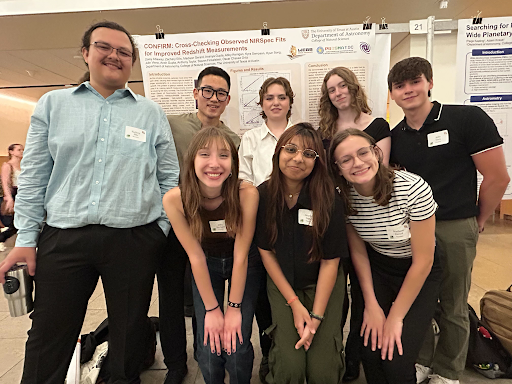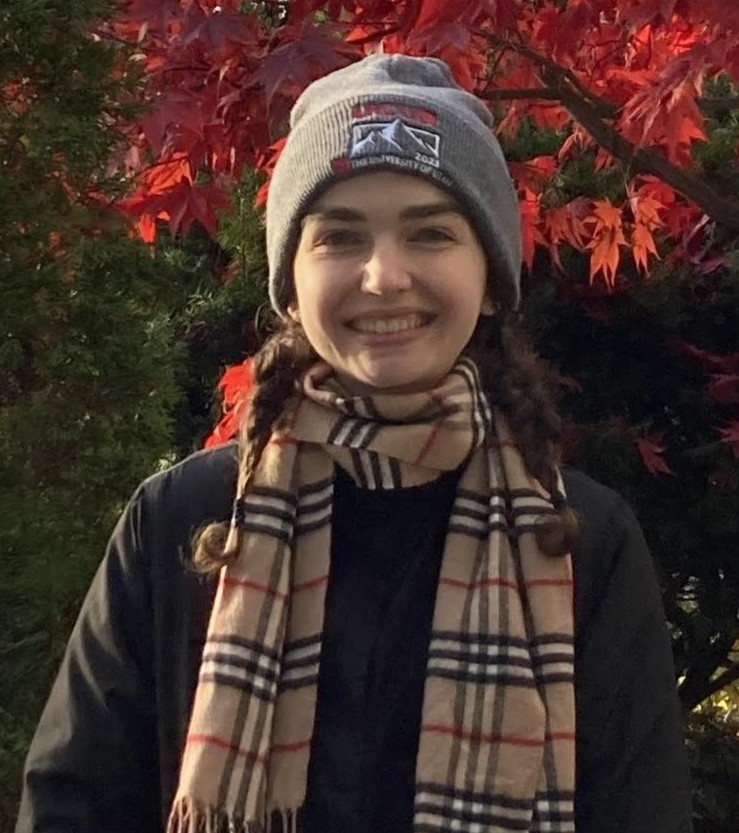Capstone Projects
Seniors
Avery Abramson
Analyzing Star Formation Histories of High-redshift and Massive Galaxies
The field of galaxy evolution encompasses many scientific questions, particularly concerning how galaxies grow to become very massive at high redshifts. By studying these galaxies’ star formation histories (SFHs), the physical processes driving their growth, including enhanced star formation efficiency, bursty star formation episodes, and feedback mechanisms, can be further understood. For instance, it is unknown when or how \(\log(M_*) > 10\) galaxies at \(z > 3\) formed the majority of their mass. My Capstone project will leverage spectro-photometric modeling with BAGPIPES to analyze data from the Santa Cruz SAM simulation to constrain the SFHs of these galaxies. Thus, I aim to uncover insights into the physical processes driving the galaxies’ rapid formation and evolution.

Gabi Oliva
Probing High-Redshift Galaxies with CEERS and Chandra: Constraining Galaxy-Scale X-ray Emission in the Epoch of Reionization

I use JWST to explore the early Universe, specifically galaxies that formed less than one billion years after the Big Bang (z>6). By combining JWST NIRCam narrow-band imaging from CEERS with deep Chandra X-ray data from AEGIS-XD, I measure the average X-ray fluxes of high-redshift galaxies selected via color-excess in the F470N filter (z = 6.2 Hα and z = 8.4 [O III]). Through X-ray stacking, I probe the roles of star formation and AGN activity in powering their X-ray emissions and their impact on Reionization and the cosmic X-ray background.
Hannah Lawson
Searching for little red dots in the late universe using the euclid survey

Little red dots (LRDs) are a type of active galactic nuclei recently discovered by the James Webb Space Telescope. These mysterious objects are characterized by their compact sizes and ‘v-shaped’ spectral energy distributions (SEDs), although the mechanism that powers these SEDs is not well understood. LRDs are typically found in the early universe, but it is necessary to probe a larger volume of the sky to search for their late-universe counterparts. Thus, I am using photometry from the Cosmic Dawn Survey, which contains data from both ground- and space-based telescopes with wider fields of view, in order to determine how prevalent LRDs are in the late universe (redshifts z = 2-4). I use criteria defined by Kocevski et al. (2024) for robustness, compactness, and spectral indices to identify a sample of LRDs. I conduct spectroscopic analysis on my LRD candidates for which this is possible via the Tracing Observables with Neural Estimation (TONE) survey. This work will lead to a greater understanding of the redshift distribution and evolution of LRDs.
Lauren Kokinakis
Analyzing the Effect of Merger Events on Galaxy Evolution Through a Star Formation Rate Comparison with CAPERS

Interactions between galaxies are considered a key driver behind evolution in the early universe, with smaller systems merging into larger galaxies. A common method for analyzing galactic evolution is comparing star formation rates (SFRs). In this project, Lauren will investigate merging galaxy evolution by studying the SFRs of non-interacting and interacting galaxies across a wide redshift range of 4 < z < 9.5 in the new CAPERS survey. First, CEERS sources will be crossmatched with CAPERS sources to ensure that mergers have photometric and spectroscopic data. Then, mergers will be visually identified using CEERS images and confirmed using Gini, Asymmetry, and second-order moment of brightness measurements. Lastly, SFRs will be derived from Gaussian fitting of Hα and OIII5007 using emcee to compare merger and non-merger evolution. This work will help understand galaxy mergers’ role in the history of galaxy formation and evolution, especially in the early universe.
Virginia Vanicek
Fitting Mid-Infrared Spectra to Discover the Relationship Between PAH and AGN in LIRGs at z~2 using JWST MIRI/LRS and Spitzer IRAC

With the need to have a clear high-redshift star formation (SF) indicator and to better understand how dust interacts with active galactic nuclei (AGN), my project works to find a relationship between polycyclic aromatic hydrocarbon emission features (PAHs), star formation indicators, and AGN. My project uses spectra and imaging (F560W and F1000W) from the James Webb Space Telescope (JWST) MIRI/LRS as well as archived Spitzer spectra for 36 galaxies (with a smaller sub-sample that host AGN). To measure this relationship, I will fit these combined JWST-Spitzer mid-infrared spectra (5-38 µm) using CAFE. After fitting the mid-infrared spectra in my sample of dusty galaxies at z≈ 2, I will specifically look at the 3.3 PAH (3.3 µm), Paschen Alpha (1.875 µm), and Bracket Alpha (4.052 µm) emission lines to derive a scaling law of PAHs to star formation and AGN for the sample.
Emma Tyler
Juniors
Abby Kerrigan, Adin Vera, Ananya Gupta, Daisy Attaway, Kyra Sampson, Maddie Gerard, and Zachary Ellis
CONFIRM: Cross-checking observed nirspec fits for improved redshift measurements

Accurate spectroscopic redshift verification is essential for classifying and categorizing high-redshift galaxies, especially as the CAPERS program continues to produce increasing volumes of JWST NIR-Spec Prism data. Currently, the CAPERS team uses PRISMATIC, a data visualization tool, to compile redshift measurements from multiple automated fitting codes, such as BAGPIPES, CIGALE, and msaexp. However, automated methods can be prone to errors due to challenges like low signal-to-noise ratios (SNR), blended emission lines, and spectral contamination. Our research, CONFIRM, focuses on systematically verifying these redshifts to produce a definitive, human-validated catalog. To achieve this, we independently calculate redshifts for 1,039 total sources and compare them against spectroscopic measurements provided by the CAPERS team. While our initial training is based on sources previously analyzed by the CAPERS team, we will soon expand our efforts to an incoming dataset of 8,000 targeted sources. This new dataset will require careful validation to ensure accurate redshift measurements for all high-redshift galaxies observed with JWST. Our verification process will not only improve the reliability of redshift measurements for CAPERS, but also provide insight into the strengths and limitations of the underlying fitting codes in PRISMATIC. Furthermore, identifying trends in emission identifications will allow for better calibration of automated methods in future studies. Ultimately, our work helps build a more accurate foundation for studying high-redshift galaxies. By combining automated fitting with this team’s calculated redshift values, we aim to improve the accuracy of redshift measurements and ensure proper categorization of thousands of new galaxies.

Alumni
Class of 2025
Arnav Shah
Insights into Galaxy Morphology from Gas Kinematics

The 3D shapes of galaxies are critical for understanding their evolution. Recently, Pandya et al. (2024) statistically showed that elongated (filamentary) galaxies dominated over disky and spheroidal galaxies ~10 billion years ago. Their study raised the question of whether gas kinematics could be used to verify purely imaging-based results. Using the JWST/NIRSpec spectra and JWST/NIRCam imaging provided by the CEERS survey, my research works to correlate the gas velocity dispersion of high-redshift galaxies against their 2D projected axis ratios. I derived the velocity dispersion by fitting a Gaussian to the Hydrogen-alpha emission line and recording its width. For a population of rotating axisymmetric gaseous disks, we expect the velocity dispersion to be larger for edge-on systems and smaller for face-on objects due to path length and viewing angle arguments. We do not find evidence of this trend for either low-mass or high-mass galaxies. This may be due to small sample statistics, spectral slit-galaxy misalignment and/or significant non-circular motions in the gas because of feedback. We are working to expand our dataset and build toy models to test our intuition of the expected trends for disks versus elongated galaxies.
Lipika Chatur
Probing gas-phase metallicity of z = 1-9 through [OIII]4364 auroral emission line analysis with CEERS and RUBIES via direct temperature method

Analyzing gas-phase metallicity across varying redshifts is significant to understanding the evolution and formation processes within galaxies. In this study, we use a sample of 262 galaxies from The Cosmic Evolution Early Release Science Survey (CEERS) and The Red Unknowns: Bright Infrared Extragalactic Survey (RUBIES). We detect the [OIII]λ4364 auroral emission line, which allows us to directly probe the electron temperatures and metallicities of the galaxies in our sample. To enhance the signal-to-noise ratio of the [OIII]λ4364 auroral emission line, we stack galaxies in discrete redshift bins from 1 < z < 9, correcting for dust attenuation. Additionally, we examine the magnitudes, masses, and star formation rates of all sources to assess potential selection biases in our sample. Our result provides us with an insight into the metallicity of galaxies across cosmic time.
Marissa Perry
The Burstiness of Star Formation: the Halpha-to-UV Ratio in Galaxies at z=1–7

Over the past few years, JWST-based studies have found an excessive number of bright galaxies in the early Universe. One potential explanation for these observations is that these galaxies experience bursty star formation, which may upscatter our observations. My work in the GEVIP group focuses on finding observational evidence for this. With sample of ~350 galaxies from the JWST CEERS and RUBIES surveys, I am measuring the Hα-to-UV luminosity ratio to determine if the star-formation rate of a given galaxy has changed significantly over the past 100 Myr.
Rahul Shaji
Star Formation Rate Density at 2 < z < 7: The Redshift Evolution of Early Galaxies with Hydrogen-Alpha Line Luminosity Functions

Observations of star formation rate density (SFRD), the total mass of stars formed per year per unit volume, are key for constraining galaxy evolution over early cosmic time. Galaxies that emit H-α spectral emission lines are strong tracers of star formation. In this poster, I present a sample of 504 H-α detected galaxies at redshifts 2 < z < 7 from the RUBIES JWST/NIRSpec Survey. First, I measure the H-α luminosity of each galaxy using a Bayesian fitting pipeline. I then use these measurements to display the number density of H-α detected galaxies at different redshifts as functions of luminosity. I apply completeness corrections to better constrain these luminosity functions (LFs) using spectral simulations and photometric cross-matching. I integrate each LF to yield SFRD as a function of redshift up to z ≈ 7, expanding far beyond previous literature results at z ≲ 2. Finally, I discuss expansions of this work that could refine these results by removing active black holes and accounting for the effects of dust in my sample, further constraining the high-redshift SFRD.
Urvi Thakurdesai
Investigating correlation between line flux ratios in high redshift (3<z<7) galaxies and AGN localization with JWST/NIRSpec
Supermassive black holes (SMBHs) play a pivotal role in galaxy evolution by influencing the ionization state of surrounding gas. To examine this effect, we analyze the spatial distribution of emission line flux ratios relative to the locations of SMBHs. Using JWST NIRSpec PRISM data from 40 high-redshift galaxies—including known broad-line active galactic nuclei (BLAGN) sources—within the CEERS survey, we use 1D and 2D spectra to map key emission lines such as H-alpha, H-beta, and [OIII]λ5007. By performing cross-sectional cuts on these lines, we investigate spatial profiles and line ratio plots to compare the distribution of [OIII]/Hβ with the galaxy centers. Our analysis reveals nine sources exhibiting spatial offsets between the ionization peaks [OIII]/Hβ and the continuum centers. Notably, all known AGNs in our sample fall within these sources. This could be explained by either off-center star-formation, or AGN wandering. This suggests a possible connection between AGN wandering and excess flux ratios, potentially offering inferences on the interplay between SMBHs and their host galaxies. Further exploration of these correlations will provide deeper insights into AGN-driven ionization and the co-evolution of SMBHs and galaxies at high redshift.

Class of 2024
Evelyn Allsup
Measuring the star formation rates of galaxies in the range z~1-3.5. Evelyn is using Ha and Hb flux values for sources in HST and MOSDEF surveys, and hunting for a corresponding Pa value in CEERS. Evelyn uses Pa to calculate a star formation rate for sources with a measurement, will recalibrate Ha and Hb SFR relation constants using these new SFRs, and for sources that don’t have Pa but have Ha and Hb will dust correct and calculate a SFR from H-alpha. Right now she is working on obtaining Flux values for Pa in the CEERS data.

Isaiah Pipkin
Isaiah conducted a statistical comparison between JWST and HST by the identification of SF-regions of nearby galaxies.

Sam Goldberg
Sam worked on identifying [OII] outflows in the z<0.5 region of HETDEX and relationship with SFRs.

Sarah Darbar
The origin of supermassive black holes at high redshift is poorly understood, with potential seed masses ranging from stellar seeds (~1-100 M☉) to large direct collapse seeds (~104-6M☉). Directly measuring the range of black hole masses at early epochs can begin to constrain these seeding models, so Sarah’s research works on measuring the time evolution of black hole masses across previously unexplored higher redshift ranges using JWST. This is accomplished by initially selecting candidate sources from image fields using the SourceXtractor++ program, probing spectra for broadline emission features, and then estimating mass through scaling relations of broadline FWHM.

Galaxy Evolution VIP
At UT Austin… "What starts here changes the world."

